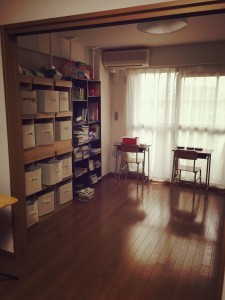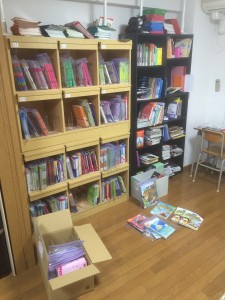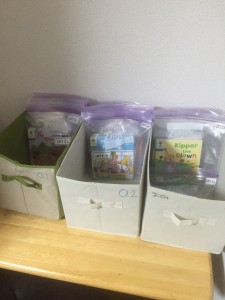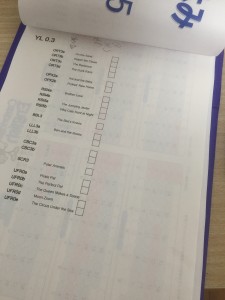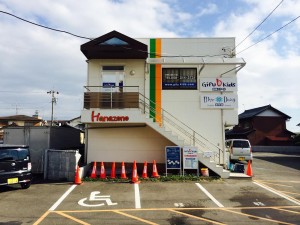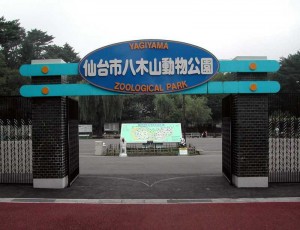Sponsoring a Teacher Visa in Japan Part 2
Wait, that was it?
As Trevor rightly pointed out in Part 1, applying for a visa as an English teacher doesn’t really involve sponsorship, but I wanted to keep the title the same for the second post. More accurately we could describe the process as ‘supplying the necessary documents to prove a viable job offer to a teacher applying for a Specialist in Humanities visa’.
Anyway, a few weeks ago I went to the immigration office with our prospective new teacher (not necessary, we just wanted someone there from the school in case there were any problems with the paperwork). We took the following paperwork with us:
From the school:
- copy of the school’s tax return (as it is a personal business)
- copy of the pamphlet
- explanation of the school
- copy of the teacher’s contract
- <we missed something>
From the teacher:
- passport
- zairyu card
- photos
- revenue stamps
- application form
- resume
We went straight to reception and talked to a very pleasant lady who checked our documents and gave us a number. After about half an hour a case officer called us up. She was unsmiling and serious until she looked at our application, then she relaxed and started smiling. I took that as a good sign.
First of all she said we were applying very early (six weeks before our new teacher’s current visa runs out) to which we replied of course that we wanted to make sure we could deal with any problems in good time.
It turns out we had forgotten to fill in the 3rd-4th pages of the application form (the school has to fill this in and stamp it), and the case officer also wanted a copy of our teacher’s current employment certificate (jirei). We could send both documents by post within the following couple of weeks. Then she said we could go.
And that was it. Very painless, even with us having messed up the paperwork.
Last week our teacher emailed me saying the notification postcard had arrived, and the visa could be collected on the first working day of August. A huge relief and a big milestone for our school: first teacher visa enabled!
Please post any questions or anecdotes in the comments below.
business curriculum eikaiwa extensive listening extensive reading graded readers high school junior high school language courses school management self-study
by sendaiben
4 comments
Extensive Reading for Secondary Students
I’ve been wanting to write this post for a long time.
On April 1st this year the language school I help out at started a new section called Cambridge Academy. Getting ready for this and implementing it over the last four weeks has been a really fun challenge, and now that we are taking a little break for the Golden Week holidays I feel like I have some lessons to share.
In this post I will talk about what we are doing, why we decided to start a new sections, and a few problems and successes we have had.
Why start a new school?
Several reasons. The main one is that we weren’t happy with our existing junior and senior high school classes. It seemed that while the most able and motivated students could do very well, others did not. We gave students many chances to do work outside of class, and the ones that did got better and the ones that didn’t, didn’t. We were looking for a way to improve that.
I was also able to visit SEG in Tokyo, and see their incredible resources and program. This inspired me to start something similar in Sendai, and we have benefited hugely from using Akio Furukawa’s experiences and advice in setting up the program.
Finally, the academy format and the results we are hoping for seem to be quite commercially viable. While my main motivation with the school is to provide students with excellent education, it’s nice if the school pays for itself too.
How does the Academy work?
There are two main concepts behind the Cambridge Academy. The first is to provide students with the chance to receive large amounts of comprehensible input through graded and leveled readers, alongside speaking and writing activities. Initially the input was based mainly on books but we quickly realised the power of reading with CDs so we have since changed this to books with CDs.
The second concept is to do 55 minutes of reading/listening in the school each week. This ensures that all students will receive at least 40 hours of reading/listening per year, or 200 hours over the course of the five years we envision the ideal program lasting (JHS 1st grade to SHS 2nd grade). Of course, motivated and ambitious students will do much more at home, but with the in-class reading system ensures that all students will make some progress.
The students will also have a speaking class with a focus on production, a writing assignment each week, and the chance to do online vocabulary study with Word Engine.
What have you done so far?
At first the main stumbling block was space: we needed an extra classroom that could house the books and other resources as well as accommodate twelve students. Luckily the apartment above the school became available in March, so we quickly rented it and set it up for school use. As the Academy classes are pretty much silent, we shouldn’t have any problems with the neighbours or the landlord.
Next was gathering resources. We already had a large graded and leveled reader collection built up over the last twelve years or so, but it wasn’t enough to serve the fifty or so students who started in April, let alone the numbers we would like to see eventually. After several large orders to englishbooks.jp and Amazon, we are still playing catchup and will probably continue buying books throughout the year (this matches my experience at Tohoku University, where book resources never quite seem to meet student demand).
Main bookshelves at the Academy.
The next step was to develop a system to determine what students would do, how we would track it, and how to organise resources. Here we benefited immensely by being able to copy a lot of what SEG does. The interesting thing is that we found ourselves adopting elements of the SEG system that didn’t make sense to me at first (like having books organised in sets with CDs, and having students read while listening).
Book sets organised using ziplock freezer bags.
We had a couple of CD players when we started classes, but after I saw how much the students enjoyed listening as they read I quickly bought ten more so that we could offer a player to each student. Personal CD players can be found on Amazon.jp for between 1500 and about 5000 yen. There seem to be limited numbers as these products are no longer popular. We have also failed to find CD players that can play MP3 CDs for a reasonable price (there is a Sony model that costs about 25,000 yen, but this seems a bit too high to me). An ongoing project.
We have also noticed the need to keep track of what each student has read so that we can give them new books in a timely way. Right now the best solution appears to be a checksheet that we will put in each students file so that we have a record of that they have read. This is also a work in progress but it is going quite well.
Checksheet to track student reading.
Results so far
The first four weeks have been great. Students seem to enjoy the format and even the students who don’t seem to enjoy English classes do the reading activities willingly. About half of the students do homework, the others do not. My policy here is to encourage and support, but leave it up to each student as to how much they want to do.
For the school, the format means that we can serve up to 24 students each weekday evening (four six-student speaking classes and two twelve-student reading classes that alternate). In practice this means that three teachers can take four classes, which increases the profitability quite a bit. The schedule looks like this:
19:20-20:15
Class A speaking with Teacher 1
Class B speaking with Teacher 2
Classes C and D reading with Teacher 3
20:25-21:20
Class C speaking with Teacher 1
Class D speaking with Teacher 2
Classes A and B reading with Teacher 3
From a business perspective the profit per student in the Academy system is higher than other classes. We charge 15,000 yen a month plus tax for 44 two-hour classes a year, so I think this is a good value for students too (they would have to pay more than that each month just to buy the books they end up reading).
The specialized knowledge required to set up the system, and the cost of books and other equipment (we’ve spent over a million yen setting up the Academy, and we already had thousands of books) means that it would be difficult for other schools to copy our classes if we are successful.
Most of all, it is wonderful to see the students enjoying their studies, and achieving success each week. The Academy style classes also work very well with students who have social issues. For a teacher, it’s a very fun class to run and I hope our students will find themselves doing better at school.
What’s next?
Well, we’ll continue developing the system and trying to improve it. I suspect motivation may become a problem for some students once the novelty wears off, but I haven’t seen this so far. Hopefully the combination of success and the contrast between an hour of reading/listening and the rest of their busy day will help stave this off.
Business-wise I would like to see the Academy grow in size, and if it gets big enough I would like to move it to a new location in the city centre to increase our catchment area. Ideally this would happen in the next year or two.
So far I am very pleased with how things are going. I’ll post an update in September or so and let you know how we are doing. Please feel free to ask any questions in the comments.
GUEST POST: Do Or Die
Securing your future in EFL
Today I am extremely pleased to feature a guest post from Mark Kulek, a school owner from Gifu. Mark is a great guy, a passionate educator, and, as you’ll see from his post below, a shrewd business owner.
First, let me thank Ben for this opportunity to share my experience with his readers.
Ben published a post that concerns me and many others who are teaching English conversation here in Japan.
Ben asked me to share what I am doing to survive in the English conversation business.
Background information:
I arrived to Japan in August of 1996 with no experience teaching English or running a business. I graduated with a degree in literature, but had no plans of teaching at that time. After graduating from my university, I worked as a sales representative. I liked it, but never really felt satisfied.
My sister left for Japan in 1992. I felt a little jealous of her. She was off to a fantastic adventure and I was still doing the same old thing. When she had come back home, she told me that I would love it in Japan. She planted a large seed in my head.
I came to Japan with one main goal, to make money.
In 1996, my group of friends were all hustling to earn money. We all had our full-time job, but that was not enough. We took on private students, part-time work and even performed as priests doing wedding ceremonies. Very early upon my arrival I knew that I could work hard and have a comfortable life. And I knew that I could make it on my own.
In 2001, I opened a conversation school. At first, I was only open a few days a week supplementing my income with part-time work. After a few years, I was busy five days a week plus I needed a part-time teacher. This situation continued. Then about four years ago things changed.
Demographics started impacting enrollment. My area was graying quite fast. Young families were not moving into my area. The local kindergarten was losing students. Two local elementary schools had to merged. From 2011, basically, I had zero new enrollments at the school. The future was looking bleak.
In the meantime, I was working at a few kindergartens part-time. One particularly valued English learning more than the others. This is the kindergarten that changed everything for me. I worked there once a week doing kanai classes. Once a week turned into twice a week plus I did after school kagai classes.
I had to make a change.
The kindergarten’s owner had a building, not being used, right next to the kindergarten. Each week I would look at that building and think, “this would be an ideal location for my English school.”
I took the principle/owner of the kindergarten out for dinner. We had a few glasses of beer, enough to get us feeling happy. I then suggested that we go into the English conversation business together. He was very positive about the prospect, but needed some time to think about it. He did and we formed a partnership. We fixed up that old building and made it the finest English conversation school in the city.
I am happy to report that our partnership is working out beautifully.
I moved into the new facility in September of 2013. 50 students from the previous location relocated with me. From September 2013 to March 2014, 22 new students have joined. From April 2014 to May13, 2014, 46 new students have joined. There are trial lessons scheduled through June. I predict that we will have new students joining throughout the academic year.
In conclusion
It’s win win for both of us. The kindergarten is providing more services, convenience, safety and personalization to their students. As for me, I’m getting job security, business help from people who have been running a kindergarten for over 50 years and financial backing. One of my biggest concerns (before the partnership) was one day being able to step back from day-to-day teaching, after all I am not getting any younger.
This partnership with the kindergarten will allow me to run a successful business. In fact, since September 2013, I have hired two part-time teachers to cover the increase of students. This has allowed me to focus on management, to help my teachers, and to make materials.
I feel I have set myself up for a long and prosperous future in the English conversation field.
I make my home in Gifu, Japan, where I have an English conversation school for both adults and young learners. I have been teaching EFL for 18 years. I’m interested in professional development and activity-based curriculums. You can find me on Twitter as @gifumark
business curriculum expectations reviews school management teaching
by sendaiben
leave a comment
Work the System – book review
(I reviewed this book previously on my book reviews blog, but am re-posting here as I think it might be helpful to readers)
Work the System, by Sam Carpenter, is a book with a very simple premise: it is possible to vastly improve your work and your life by concentrating on systems.
In a similar vein to Tim Ferriss, Carpenter emphasizes the gains to be made when everyday tasks are optimized and automated. He advocates writing down step-by-step instructions for any task that has to be performed regularly.
The premise is obvious, but after just one reading I have identified dozens of areas in my own life where I can apply this. The upside seems enormous.
For teachers, this would involve writing a class manual for your students that describes all the tasks they must perform. At Tohoku University, thanks to the mad organizational skills of my colleague Dan E., we already have something like this, and it makes teaching almost effortless.
Essential to entrepreneurs and small-business owners, this book should also prove useful for classroom teachers. Extremely recommended, unless you are already a happy productivity ninja with a great life 🙂
business eikaiwa kids school management study trips summer camp young learners
by sendaiben
leave a comment
Eikaiwa School Field Trips: Summer at the Zoo
Every year we organize some kind of optional summer event for our students. Past events have included ice skating (feels weird to put on sweaters and gloves in August!), outdoor games, playing in a river, and trips to the seaside. This year we decided to go to Yagiyama Zoo in Sendai with our preschool- and elementary school-aged students.
Before the trip we visited the zoo to plan out routes and activities, bought small sketchbooks for all the students, divided them into groups and assigned teachers to lead each group.
There was a slight problem with the timing of the announcement coinciding with the school being closed for some classes, so that some parents only got the announcement letter after the trip was full! We did our best to accommodate them which led to us needing a larger bus and the groups getting a bit too big for the number of teachers we had (several were away due to the summer holidays).
Then the day before the excursion the weather reports changed from sunny with cloudy spells to rain (60%). Then that evening rain (70%). The next morning the ground was wet when we woke up at six am, but by seven it was raining. By eight thirty (the deadline for making a decision) it was raining heavily.
Fortunately we had a plan B. We had made arrangements to go to the aquarium at Matsushima in the event of rain. This was not ideal, but preferable to cancelling and being out of pocket for the bus hire and other expenses.
The problem with the aquarium is that we hadn’t had time to visit and make plans. It was also much more expensive than the zoo, and smaller. We weren’t sure if there was enough to do there for the four hours we had planned.
Lessons Learned
We learned a lot from this year’s trip. Here are some of the most important things:
1. Having a plan B is essential if weather could impact on your trip. What were the chances of the only rainy day for weeks and weeks being the day we were going to the zoo? Because we had a plan B and had told the students and parents about it our trip wasn’t ruined. However, we should have put more time into getting ready for plan B.
2. Accurately estimating demand, making sure the sign-up process is fair to everyone, and sticking to deadlines and limits on numbers of students is important. We didn’t have any major problems this time, but the large numbers of students made things more difficult for our teachers (I found myself supervising sixteen young children for much of the day, and it was too many for comfort).
3. The number of seats quoted by bus companies include those fold-down seats in the middle. I don’t like them because they are uncomfortable, seem less safe, and mean that it is not possible for teachers to move around the bus when they are in use. In the future, I would like to make sure all the students have a proper seat, with only teachers in the middle seats if necessary.
Conclusion
In the end the trip turned out well. The aquarium had just enough to keep us busy (looking at the fish, drawing pictures, watching the sealion show, shaking hands with a sealion, meeting baby turtles, wading in a big pool, etc.). It was also great that they had a large seating area that wasn’t at all busy, so we could sit the students down in groups and talk to them, have them draw pictures, and eat lunch in an orderly fashion.
I think we were both unlucky (the weather) and lucky (everything turned out fine and the students enjoyed themselves). We also got a few insights for next year.
Does anyone else do field trips?

